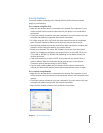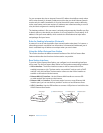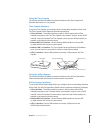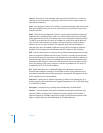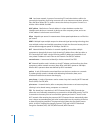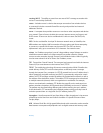
Glossary 67
firewall A system of software and/or hardware that resides between two networks to
prevent access by unauthorized users. The most common use of a firewall is to provide
security between a local network and the Internet. Firewalls can make a network
appear invisible to the Internet and can block unauthorized and unwanted users from
accessing files and systems on the network. Hardware and software firewalls monitor
and control the flow of data in and out of computers in both wired and wireless
enterprise, business and home networks. They can be set to intercept, analyze, and
stop a wide range of Internet intruders and hackers.
gateway In the wireless world, a gateway is an access point with additional software
capabilities such as providing NAT and DHCP. Gateways may also provide VPN support,
roaming, firewalls, various levels of security, and so on.
hotspot A location where users can access the Internet using Wi-Fi laptops and other
Wi-Fi enabled devices. Access may be provided free or for a fee. Hotspots are often
found at coffee shops, hotels, airport lounges, train stations, convention centers, gas
stations, truck stops, and other public meeting areas. Corporations and campuses often
offer hotspot service to visitors and guests. Hotspot service is sometimes available
aboard planes, trains, and boats.
hub A multiport device used to connect client devices to a wired Ethernet network.
Hubs can have numerous ports and can transmit data at speeds ranging from 10 to
1000 Mbps to all the connected ports. A small wired hub may only connect 4
computers; a large hub can connect 48 or more. See router.
IEEE 802.11 The family of specifications developed by the Institute of Electrical and
Electronics Engineers (IEEE) 802.11 committee, which establishes standards for wireless
Ethernet networks. 802.11 standards define the over-the-air interface between wireless
clients and a base station, or an access point that is physically connected to the wired
network.
IP Internet Protocol. The basic communications protocol of the Internet. See IP
address, TCP/IP.
IP address Internet Protocol address. IP Version 4, the most widely used Internet
protocol, provides a 32-bit number that identifies the sender or receiver of information
sent across the Internet. An IP address has two parts: The identifier of the particular
network on the Internet and the identifier of the particular device (which can be
a server or a workstation) within that network. The newer IP, Version 6, provides a
128-bit addressing scheme to support a much greater number of IP addresses.
See DHCP, DNS, IP.
IP subnet An IP subnet is a local network as defined by IP network numbers.
Connecting to a subnet involves connecting to the appropriate hardware network and
configuring IP for that network.



